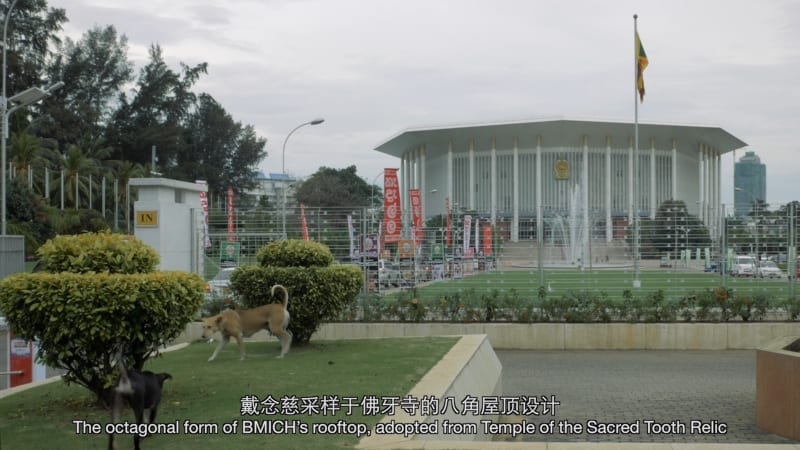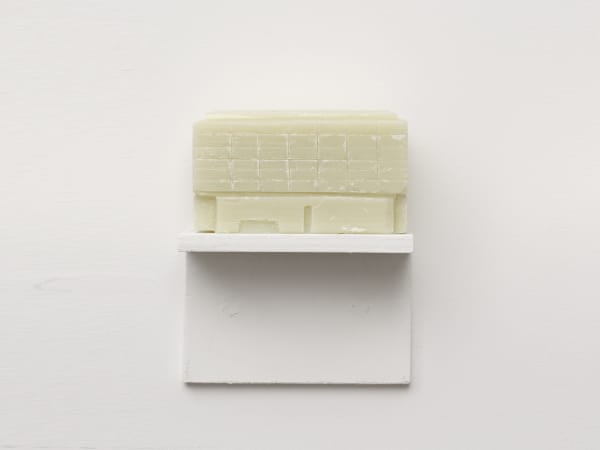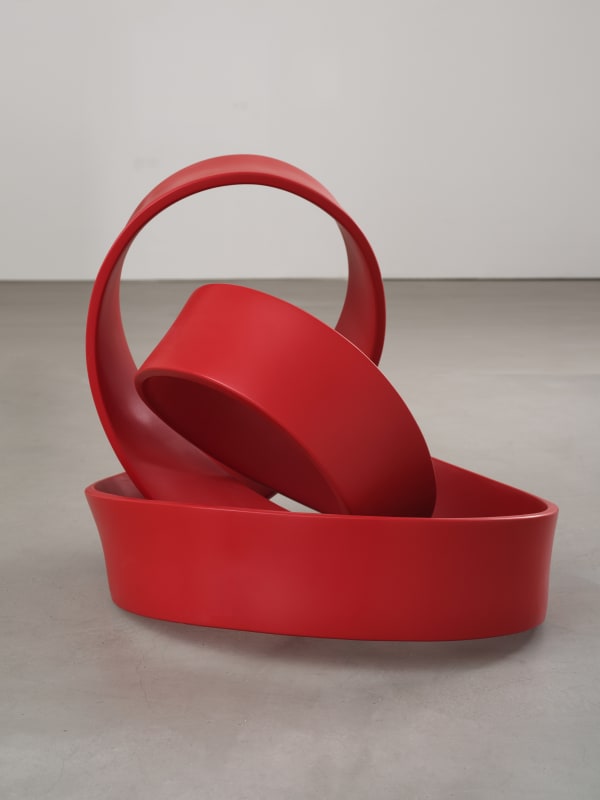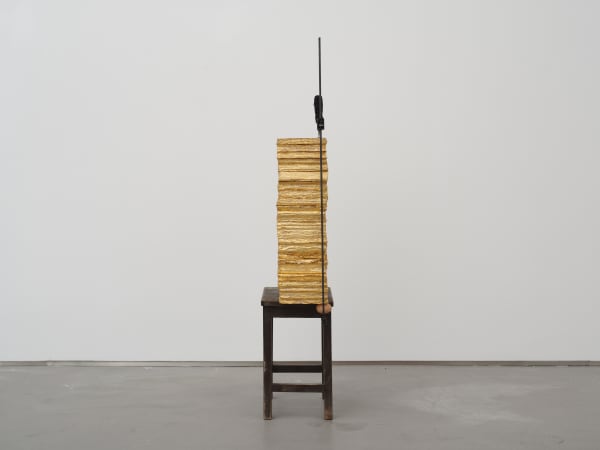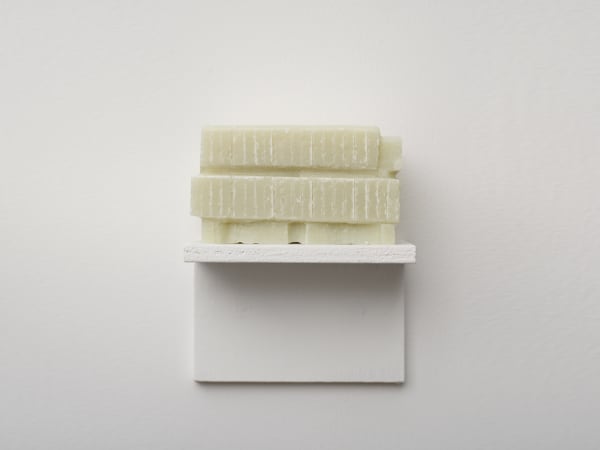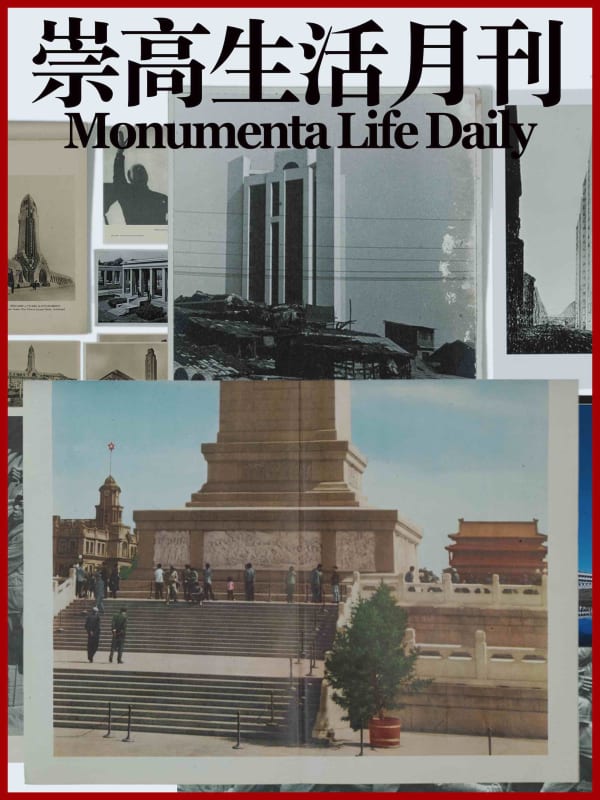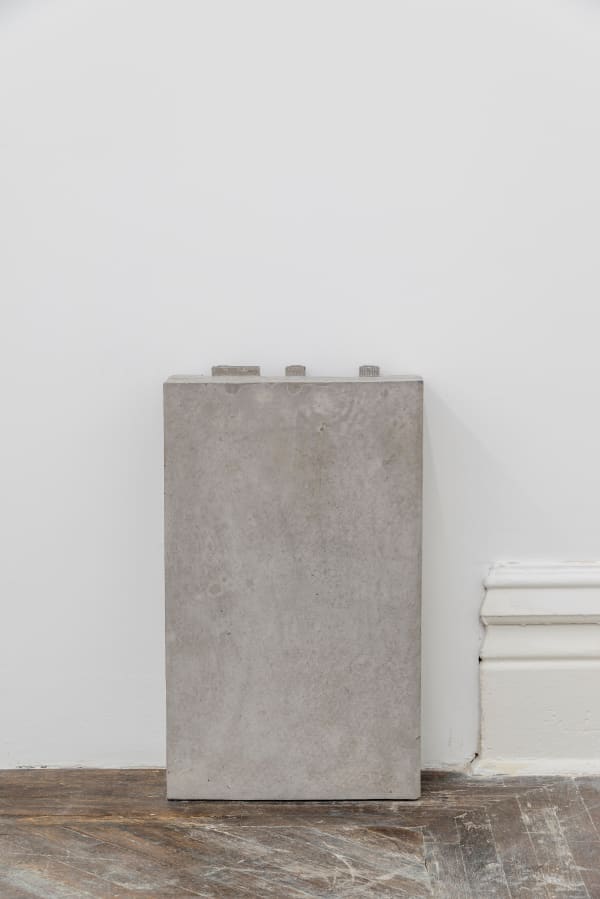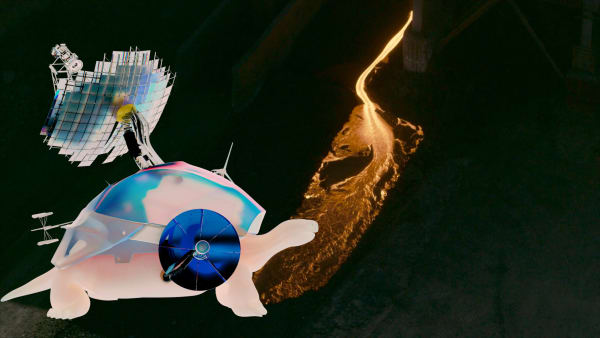Installation Views
Overview
In sync with the mission to commit fully to urban industrial production, the People’s Daily editorialised against waste in nonproductive construction, the ancillary facilities of the productive kind, in a series of articles which had titles such as: “Turn Consumer Cities into Producer Cities” (17 March 1949); “Close Cooperation Between Urban Construction and Industrial Construction” (4 January 1953); “Build Cities According to the Principles of Applicability, Economy, and Beauty” (7 January 1954); “Oppose Waste in Architecture” (28 March 1954); “Steadfastly Lower the Standards in Nonproductive Construction” (19 June 1955); and “Economising Principles Shall be Applied in Urban Construction” (24 May 1957). Common features included: the addition of the “big roof” to office buildings, later refuted by Liang Sicheng who proved himself a tireless advocate of “national form;” the arrangement of staff quarters, sanatoriums, assembly halls, recreation clubs and other sorts of places to live in general working units; and the retention of unnecessary trimmings and false structures in dozens of projects.
The hypercorrectness of the “Anti-Formalism, Anti-Reactionism and Anti-Waste” campaign in the field of architecture during the 1950s had merely resulted in the excessive pursuit of aggressive cost-saving behaviours. Continuing at the low-end of the expense scale could only prolong the problem of wasteful uses and disposes. In fact, in order to fulfil the function of “socialist content,” modern Chinese architecture began borrowing hugely from the Soviet Union and its totalist style, thereby readily indulging in monumentality. Plenty of magnificent civic and public buildings can thus perform beyond the category of general infrastructure. They are the physical embodiment of institutions, ideologies and media politics, encouraging the construction of those textual aspects of the Chinese experience, or more likely manifesting themselves as diplomatic means and geopolitical tools. In particular, with the advent of reform and opening up, it is clear that socio-economic progress can find expression in the heights of commercial buildings and the dimensions of surrounding complexes, while the incredible construction speed of “one floor in three days” saw the breaking of records in Chinese architectural history.
Although, for now, no longer a dependency of productive construction, nonproductive construction is symbiotically linked to the real estate industry, which plays a seminal role in the market economy system. Following a rigorous and complete set of design specifications to meet higher requirements, there is still waste, as witnessed by the common occurrence of unfinished buildings and demolition sites. The essential benefits for most people in terms of housing issues, in particular the acute shortage of decent housing, are fixed as a contradiction in itself of China’s modernisation. Yet, the lack of a common design language has resulted in mountains of poor copies of classical Western construction landscapes.
The aim of this exhibition entitled “Steadfastly Raise the Standards in Nonproductive Construction” is to investigate the modern paradoxes within Chinese architectural culture. Facilitating the integration of various architectural images will provoke perceptions of our dwelling spaces, lived environments, senses of place as well as their media forms and historical productions. Henri Lefebvre—the initiator of the Marxist approach for urban studies—deems that concrete spatial forms like houses, monuments, and works of art are generated from the interaction between competing powers. He proposes the spatial triad as a framework for analysis: Representations of Space—the abstract space produced by technocrats, planners, and architects through discourses and words of knowledge; Representational Spaces—the revolutionary space where habitants and users seek for changes by complex semiotic systems and associated memories; and Spatial Practices—the joint experience that mediates between the above two categories.
If “Steadfastly Lower the Standards in Nonproductive Construction” falls into a representation of space, “Steadfastly Raise the Standards in Nonproductive Construction” can be used to refer to representational space. The reverse is also true that they both correspond to unique political appeals at different periods of time. As a consequence, the exhibition is designed to present the shifting dynamics between both, about how artists as social individuals carry through spatial practices with their spatial abilities and rights to the space. The curatorial gesture is expected to demonstrate nonproductive construction as being the open container or carrier, thereby reflecting the distinctive path of the development of Chinese modernisation and its parallel trajectories.
The body of work on show represents the intersection of private and public spheres, reflecting the ways in which the idea of nonproductive construction has been miniaturised, multiplied or fragmented. James CARL’s aluminum cast sculpture is produced as the communal and accommodative structure of rubber band, a utopian enclosure. Out of building materials and natural plants, ZHANG Ruyi devises a different kind of urban environment, a derelict land as described by J. G. Ballard in his novel Concrete Island (1974). In a similar vein, Jeehee PARK applies mirror film, the “skin” of the glass curtain façades, to collage her perception of the gentrification process in major cities, while Trevor YEUNG installs strings of lightbulbs to whitewash its surrounding works, a provoking conduct sufficient to justify some political messages. Lauren Davis FISHER’s gloves as hangings suggest the “handling” and “non-handling” of labour as an body issue. Such alienated experience is also at the heart of SHI Xiaobo’s painting, which creates a generic model of dwelling.
In another aspect, the exhibition features artists who envisage nonproductive construction as the mining tool for reflexive modernity, or even the responsible object that embodies the sustainable ideologies in wider socio-historical realities. The small landscape work by LI Shan documents a wilderness of Chinese roofs in central Beijing of the 1970s, a view through the apartment window of Fusuijing Building—the aggregated house practicing the conception of “social condenser” as promoted by Soviet Constructivist architects in the 1920s. ZHANG Yunyao fictions a fairyland of waste to give an embellished account of industrial collectivisation as a legacy. PU Yingwei revisits the intellectual play of circulating photographic images with the institution of advertising to explore new horizons of monumental propaganda, part of Lénin’s plan. FENG Junyuan and ZENG Jiahui take the genre of poetry film to review the exported architectural project completed from 1964 to 1973—Bandaranaike Memorial International Conference Hall, Colombo, Sri Lanka, which profoundly marked the theory of “architectural translatability” coined with the linguistic turn of the discipline in modern China. As a response, Tant ZHONG celebrates the signing of Sino-Lanka (then Ceylon) Rubber-Rice Pact in 1952 under the framework of the Non-aligned Movement by empowering the coupling between the two materials.
Speaking of the fundamental structural transformations taking place in the recent history since China has reentered the global system, HU Zi portrays the American artist Robert Rauschenberg (1925–2008), whose seminal exhibition at the institution now known as the National Art Museum of China in 1985 facilitated the movement of “'85 New Wave.” FEI Yining’s animated video New Clear War offers a decolonial perspective on Chinese solar panel industry, illustrating how it battles through fiercely competitive circumstances across the globe. Referring to an architectural event as a matter of life and death, LIU Ren performs an ambitious rethinking of the destruction of the twin towers of the World Trade Center during the September 11 attacks by fabricating its consumed base (or substructure) with some daily necessities, thus rendering the superstructure of late capitalism termed as the golden age. Becky KOLSRUD paints the security gates and crisscrossing fences that can be readily found in the streets of Los Angeles, where the matter of life and death comes up again to focus on urban violence born of simmering racial tensions.
The hypercorrectness of the “Anti-Formalism, Anti-Reactionism and Anti-Waste” campaign in the field of architecture during the 1950s had merely resulted in the excessive pursuit of aggressive cost-saving behaviours. Continuing at the low-end of the expense scale could only prolong the problem of wasteful uses and disposes. In fact, in order to fulfil the function of “socialist content,” modern Chinese architecture began borrowing hugely from the Soviet Union and its totalist style, thereby readily indulging in monumentality. Plenty of magnificent civic and public buildings can thus perform beyond the category of general infrastructure. They are the physical embodiment of institutions, ideologies and media politics, encouraging the construction of those textual aspects of the Chinese experience, or more likely manifesting themselves as diplomatic means and geopolitical tools. In particular, with the advent of reform and opening up, it is clear that socio-economic progress can find expression in the heights of commercial buildings and the dimensions of surrounding complexes, while the incredible construction speed of “one floor in three days” saw the breaking of records in Chinese architectural history.
Although, for now, no longer a dependency of productive construction, nonproductive construction is symbiotically linked to the real estate industry, which plays a seminal role in the market economy system. Following a rigorous and complete set of design specifications to meet higher requirements, there is still waste, as witnessed by the common occurrence of unfinished buildings and demolition sites. The essential benefits for most people in terms of housing issues, in particular the acute shortage of decent housing, are fixed as a contradiction in itself of China’s modernisation. Yet, the lack of a common design language has resulted in mountains of poor copies of classical Western construction landscapes.
The aim of this exhibition entitled “Steadfastly Raise the Standards in Nonproductive Construction” is to investigate the modern paradoxes within Chinese architectural culture. Facilitating the integration of various architectural images will provoke perceptions of our dwelling spaces, lived environments, senses of place as well as their media forms and historical productions. Henri Lefebvre—the initiator of the Marxist approach for urban studies—deems that concrete spatial forms like houses, monuments, and works of art are generated from the interaction between competing powers. He proposes the spatial triad as a framework for analysis: Representations of Space—the abstract space produced by technocrats, planners, and architects through discourses and words of knowledge; Representational Spaces—the revolutionary space where habitants and users seek for changes by complex semiotic systems and associated memories; and Spatial Practices—the joint experience that mediates between the above two categories.
If “Steadfastly Lower the Standards in Nonproductive Construction” falls into a representation of space, “Steadfastly Raise the Standards in Nonproductive Construction” can be used to refer to representational space. The reverse is also true that they both correspond to unique political appeals at different periods of time. As a consequence, the exhibition is designed to present the shifting dynamics between both, about how artists as social individuals carry through spatial practices with their spatial abilities and rights to the space. The curatorial gesture is expected to demonstrate nonproductive construction as being the open container or carrier, thereby reflecting the distinctive path of the development of Chinese modernisation and its parallel trajectories.
The body of work on show represents the intersection of private and public spheres, reflecting the ways in which the idea of nonproductive construction has been miniaturised, multiplied or fragmented. James CARL’s aluminum cast sculpture is produced as the communal and accommodative structure of rubber band, a utopian enclosure. Out of building materials and natural plants, ZHANG Ruyi devises a different kind of urban environment, a derelict land as described by J. G. Ballard in his novel Concrete Island (1974). In a similar vein, Jeehee PARK applies mirror film, the “skin” of the glass curtain façades, to collage her perception of the gentrification process in major cities, while Trevor YEUNG installs strings of lightbulbs to whitewash its surrounding works, a provoking conduct sufficient to justify some political messages. Lauren Davis FISHER’s gloves as hangings suggest the “handling” and “non-handling” of labour as an body issue. Such alienated experience is also at the heart of SHI Xiaobo’s painting, which creates a generic model of dwelling.
In another aspect, the exhibition features artists who envisage nonproductive construction as the mining tool for reflexive modernity, or even the responsible object that embodies the sustainable ideologies in wider socio-historical realities. The small landscape work by LI Shan documents a wilderness of Chinese roofs in central Beijing of the 1970s, a view through the apartment window of Fusuijing Building—the aggregated house practicing the conception of “social condenser” as promoted by Soviet Constructivist architects in the 1920s. ZHANG Yunyao fictions a fairyland of waste to give an embellished account of industrial collectivisation as a legacy. PU Yingwei revisits the intellectual play of circulating photographic images with the institution of advertising to explore new horizons of monumental propaganda, part of Lénin’s plan. FENG Junyuan and ZENG Jiahui take the genre of poetry film to review the exported architectural project completed from 1964 to 1973—Bandaranaike Memorial International Conference Hall, Colombo, Sri Lanka, which profoundly marked the theory of “architectural translatability” coined with the linguistic turn of the discipline in modern China. As a response, Tant ZHONG celebrates the signing of Sino-Lanka (then Ceylon) Rubber-Rice Pact in 1952 under the framework of the Non-aligned Movement by empowering the coupling between the two materials.
Speaking of the fundamental structural transformations taking place in the recent history since China has reentered the global system, HU Zi portrays the American artist Robert Rauschenberg (1925–2008), whose seminal exhibition at the institution now known as the National Art Museum of China in 1985 facilitated the movement of “'85 New Wave.” FEI Yining’s animated video New Clear War offers a decolonial perspective on Chinese solar panel industry, illustrating how it battles through fiercely competitive circumstances across the globe. Referring to an architectural event as a matter of life and death, LIU Ren performs an ambitious rethinking of the destruction of the twin towers of the World Trade Center during the September 11 attacks by fabricating its consumed base (or substructure) with some daily necessities, thus rendering the superstructure of late capitalism termed as the golden age. Becky KOLSRUD paints the security gates and crisscrossing fences that can be readily found in the streets of Los Angeles, where the matter of life and death comes up again to focus on urban violence born of simmering racial tensions.
Works
-
 FENG Junyuan + ZENG JiahuiTwo or Three Kinds of Heat (Chapter One) 炎热几种(其一), 2018Single channel HD video 单通道数字录像00:12:08
FENG Junyuan + ZENG JiahuiTwo or Three Kinds of Heat (Chapter One) 炎热几种(其一), 2018Single channel HD video 单通道数字录像00:12:08 -
 PU YingWeiProductive Architecture一0002 生产性建筑一0002, 2018Hand carving on Salonde Marseilles 手工雕刻于马赛香皂9.2 x 5.2 x 4 cm
PU YingWeiProductive Architecture一0002 生产性建筑一0002, 2018Hand carving on Salonde Marseilles 手工雕刻于马赛香皂9.2 x 5.2 x 4 cm -
 James CARLThing's End 皮相筋, 2015Cast aluminum 铸铝127 x 123 x 150 cm
James CARLThing's End 皮相筋, 2015Cast aluminum 铸铝127 x 123 x 150 cm -
 LIU Ren 刘任Crash 撞击, 2018Oil paint, acrylic, UV printing, straw paper, gold foil, egg, wooden bench and steel bar clamp (readymade) 油彩,丙烯,UV打印,草纸,金箔,鸡蛋,木凳与木工夹 (现成品)49 x 26 x 137 cm
LIU Ren 刘任Crash 撞击, 2018Oil paint, acrylic, UV printing, straw paper, gold foil, egg, wooden bench and steel bar clamp (readymade) 油彩,丙烯,UV打印,草纸,金箔,鸡蛋,木凳与木工夹 (现成品)49 x 26 x 137 cm -
 Jeehee PARKNonhyun-dong (When does a rectangle look like a parallelogram?) 论岘洞(长方形何时看起来像平行四边形?), 2015UV mirror film on acrylic panel 丙烯塑料板上UV镜膜90 x 90 x 0.5 cm
Jeehee PARKNonhyun-dong (When does a rectangle look like a parallelogram?) 论岘洞(长方形何时看起来像平行四边形?), 2015UV mirror film on acrylic panel 丙烯塑料板上UV镜膜90 x 90 x 0.5 cm -
 PU YingWeiProductive Architecture一0001 生产性建筑一0001, 2018Hand carving on Salonde Marseilles 手工雕刻于马赛香皂9.2 x 5.2 x 4 cm
PU YingWeiProductive Architecture一0001 生产性建筑一0001, 2018Hand carving on Salonde Marseilles 手工雕刻于马赛香皂9.2 x 5.2 x 4 cm -
 PU YingWeiProductive Architecture一0005 生产性建筑一0005, 2018Hand carving on Salonde Marseilles 手工雕刻于马赛香皂33.5 x 5.8 x 5.8 cm
PU YingWeiProductive Architecture一0005 生产性建筑一0005, 2018Hand carving on Salonde Marseilles 手工雕刻于马赛香皂33.5 x 5.8 x 5.8 cm -
 PU YingWeiProductive Architecture一0003 生产性建筑一0003, 2018Hand carving on Salonde Marseilles 手工雕刻于马赛香皂9.2 x 5.2 x 4 cm
PU YingWeiProductive Architecture一0003 生产性建筑一0003, 2018Hand carving on Salonde Marseilles 手工雕刻于马赛香皂9.2 x 5.2 x 4 cm -
 Lauren Davis FISHERBlue Gloves 蓝色手套, 2018Wood 木40.64 x 11.43 x 3.18 cm
Lauren Davis FISHERBlue Gloves 蓝色手套, 2018Wood 木40.64 x 11.43 x 3.18 cm -
 Becky KOLSRUDShoe / Gate / Landscape 鞋 / 门 / 景观, 2018Oil on Canvas 布面油画167.64 x 147.32 cm
Becky KOLSRUDShoe / Gate / Landscape 鞋 / 门 / 景观, 2018Oil on Canvas 布面油画167.64 x 147.32 cm -
 PU YingWeiMonumenta Life Daily (Fictive Verticality)崇高生活周刊 (垂直的虚构), 2018Archival inkjet print 艺术微喷200 x 150 cm
PU YingWeiMonumenta Life Daily (Fictive Verticality)崇高生活周刊 (垂直的虚构), 2018Archival inkjet print 艺术微喷200 x 150 cm -
 ZHONG TantThe Rice Wall一02 米墙一02, 2018Rice, Self adhesive PVC film 大米,自粘塑胶纸164 x 16 x 26 cm
ZHONG TantThe Rice Wall一02 米墙一02, 2018Rice, Self adhesive PVC film 大米,自粘塑胶纸164 x 16 x 26 cm -
 YEUNG TrevorChaotic Suns (White) 混乱太阳群(白), 2018Lightbulbs, cables, sockets 灯胆,电线,插头113 cm
YEUNG TrevorChaotic Suns (White) 混乱太阳群(白), 2018Lightbulbs, cables, sockets 灯胆,电线,插头113 cm -
 ZHANG Ruyi 张如怡Density 比重, 2016Concrete and iron 混凝土和铁29 x 13.2 x 47.8 cm
ZHANG Ruyi 张如怡Density 比重, 2016Concrete and iron 混凝土和铁29 x 13.2 x 47.8 cm -
 FEI YiningNew Clear War 新清洁战争, 2018Single channel HD video 单通道数字录像00:04:43 loop
FEI YiningNew Clear War 新清洁战争, 2018Single channel HD video 单通道数字录像00:04:43 loop -
 SHI Xiaobo, Ideal Building 理想住所, 2015
SHI Xiaobo, Ideal Building 理想住所, 2015 -
 ZHANG Yunyao 张云垚A Place Towards the Past 一个通向过往的地方, 2012Acrylic on canvas 布面丙烯92 x 135 cm
ZHANG Yunyao 张云垚A Place Towards the Past 一个通向过往的地方, 2012Acrylic on canvas 布面丙烯92 x 135 cm









